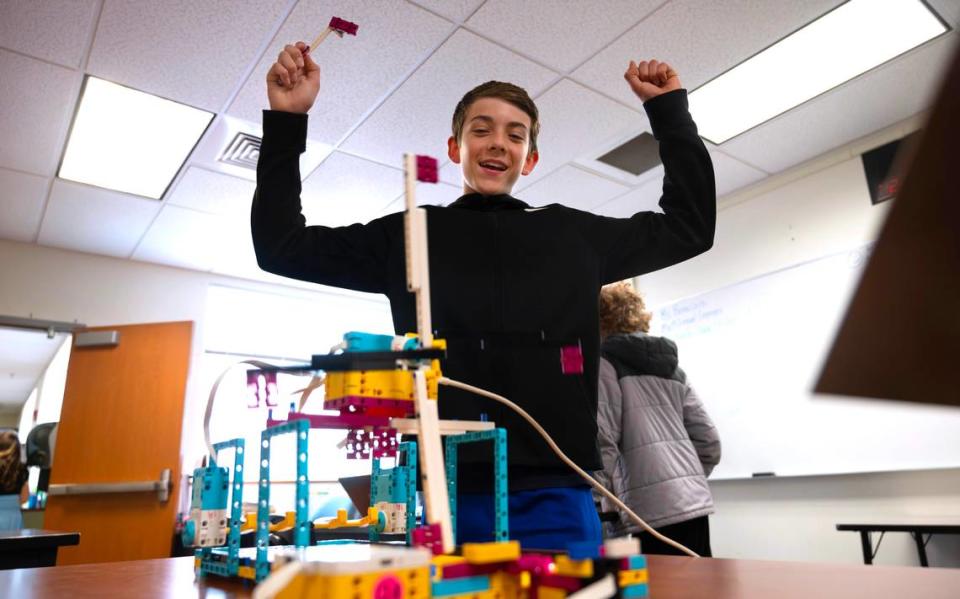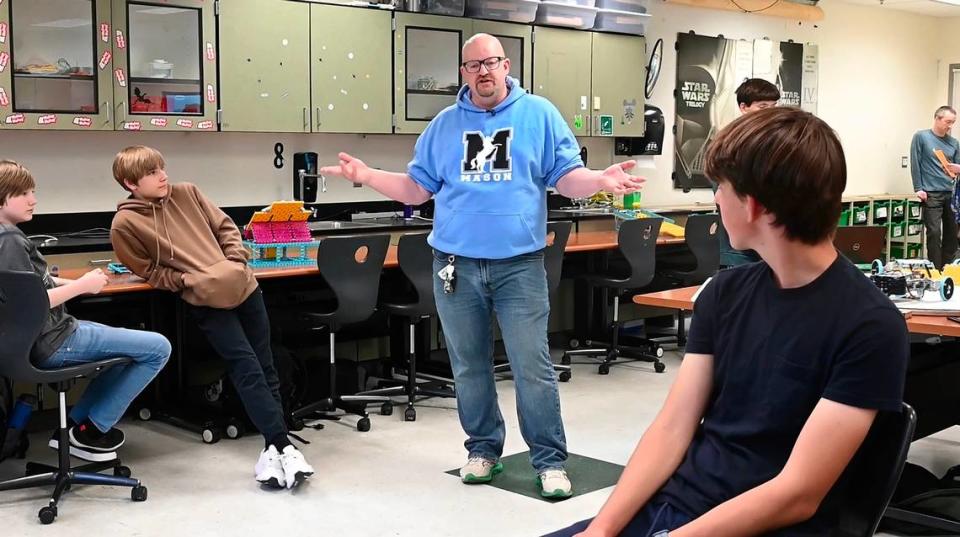What’s the best way for kids to learn? With LEGOs and robots, this Tacoma teacher says
The bell rang, and students started streaming into the classroom in twos and threes. Chatter filled the room as one booming voice shouted directions.
Around 60 students gathered for teacher Ian Chow-Miller’s biannual Robotics Carnival at Mason Middle School Thursday. It’s the third carnival he’s hosted at Mason for students to showcase their work in his robotics classes.
“Everything is awesome. Just go with it,” Chow-Miller said to students, encouraging them to consider that likely none of the adult visitors coming to the carnival that day had built a robot using LEGOs before. He later wrote in an email that he might have been consciously or subconsciously referencing the song from the LEGO movie.
The robots, themed around carnival games, had names like “Dropper Thing Mo-Bob-Er,” a game similar to a pinball machine, and “The Epic Maze,” a rolling ball maze game. Wires connected LEGO brick builds to computers that showed students’ code.
The carnival comes as part of a long teaching journey for Chow-Miller that spans nearly three decades — a journey that has given him an appreciation for nurturing kids’ creativity.

One of the most rewarding things about teaching robotics is that there is no right answer, Chow-Miller said.
“When you didn’t make (a robot) work 22 times, that was a better way of you learning than me telling you you’re wrong, or you getting a wrong answer on a sheet, or you getting a red mark on a piece of paper,” he continued. “You learn because your robot flopped over and didn’t work.”
Chow-Miller said he got his start teaching social studies in New York before moving to Pierce County in 2008. He taught for several years at Frontier Middle School in the Bethel School District, where his robotics curriculum became mandatory for seventh graders in the district. Then he became a career and technical education teacher at Mason Middle School. While teaching in the South Bronx, he learned about robotics at a teacher training and started coaching FIRST Lego League, a global STEM education and robotics program for kids up to age 16 in the U.S.
He said via email that students in his Robotics II class at Mason are graded based on meeting minimum requirements with their robots, like having at least one motor and one sensor, emitting lights or sounds, and containing a screen that provides feedback information.
“However, I also told them if they had a great interactive game that didn’t meet all of these requirements, they could just show it to me, and we could talk about why it still is awesome and deserves an A,” Chow-Miller wrote.

Chow-Miller is one of four LEGO Education Ambassadors in Washington state this year, according to LEGO Education, and has been using LEGO Education kits in his classroom for several years. LEGO Education is a division of The LEGO Group that is distinct from the retailer and works with schools to integrate LEGOs into curriculum.
LEGO Education Ambassadors are early learning to middle school teachers who use LEGO Education products as teaching tools and share best practices with each other. It is a volunteer group and ambassadors apply to join the cohort.
According to LEGO Education Key Account Manager Amelia Crespo, schools or school districts pay for the LEGO bricks, but the curriculum and coding software — called SPIKE Prime for middle school students — are available to educators for free. The cost for 15 SPIKE Prime kits, which allows a class of 30 students to work on robots in pairs, is about $6,000, but the actual price of the program depends on the school, number of students served, type of materials used, and other factors. The kits are a one-time investment and can be purchased with grant funds for year-over-year use. LEGO Education’s website says they can help teachers find grants.
Students at the carnival talked about their projects, which allowed them to apply skills they learned in Chow-Miller’s class.
“The teacher is really good, and you just get to experiment (with) like what works and what doesn’t, with this,” Nolan Mattson, one of the students who worked on the “Dropper Thing Mo-Bob-Er,” said. “And every single one of our things (is) different and I just think that’s cool.”
Seventh graders Madison Croke and Violet Stanfill said they became closer friends through Chow-Miller’s class. The two worked together on a robot they called “Friend Hunt,” a game inspired by Duck Hunt where miniature paper cut-outs of Chow-Miller’s face and other classmates are attached to a moving conveyor belt and serve as moving targets for a projectile.
Croke said she signed up for robotics next year as well.
“This has made me think a lot more about stuff,” Croke said.
Correction: An earlier version of this article misspelled the name of Violet Stanfill. The article has been updated with the proper spelling.

